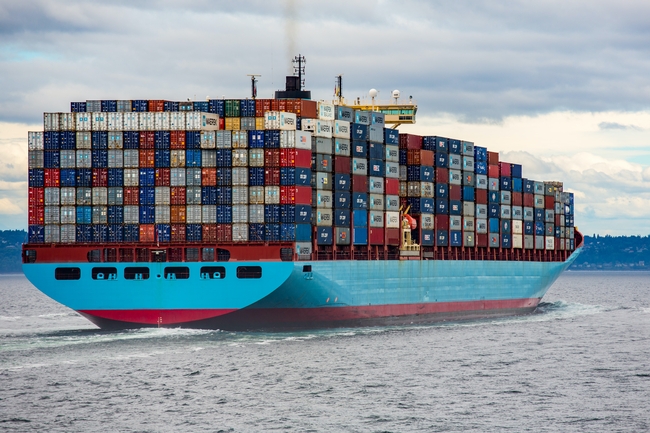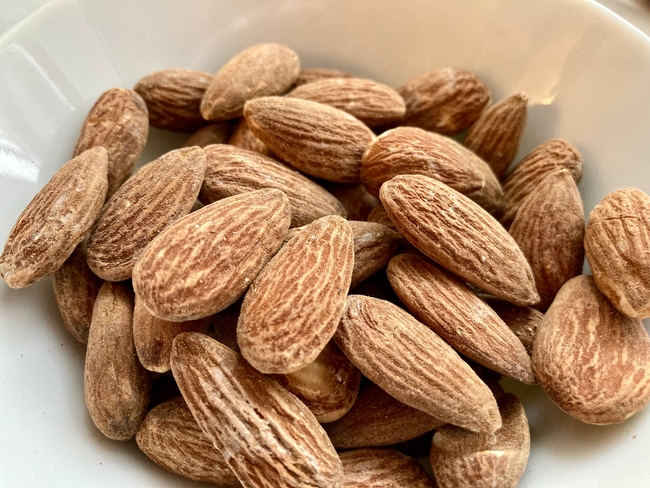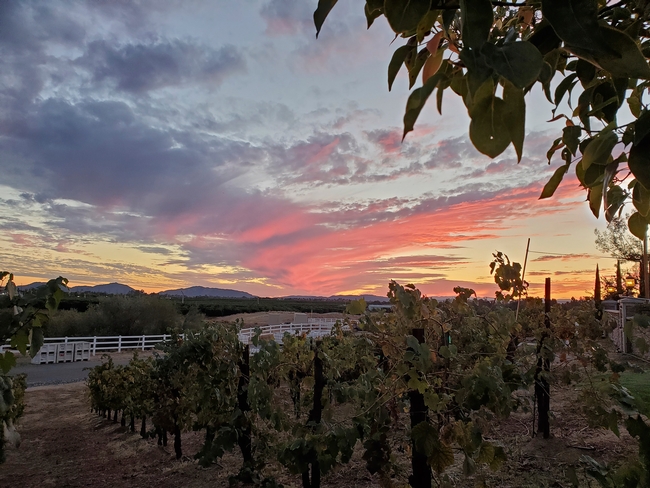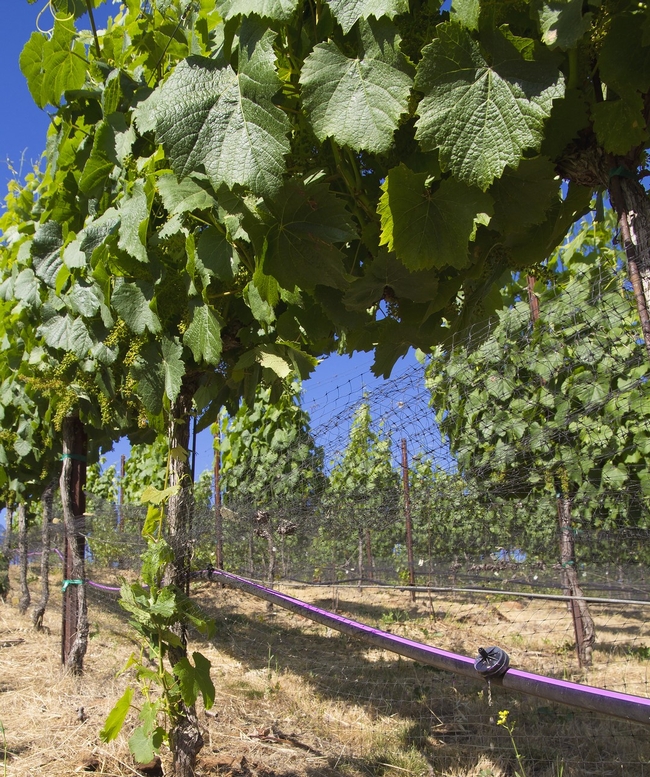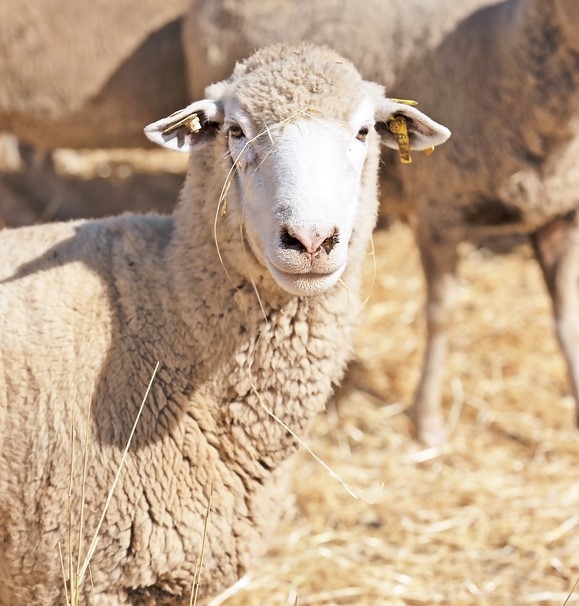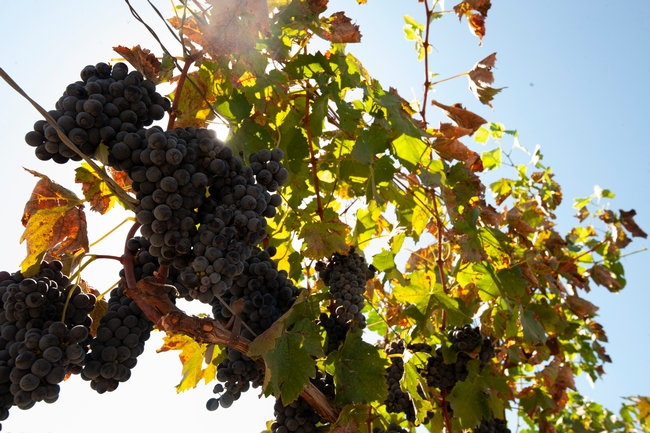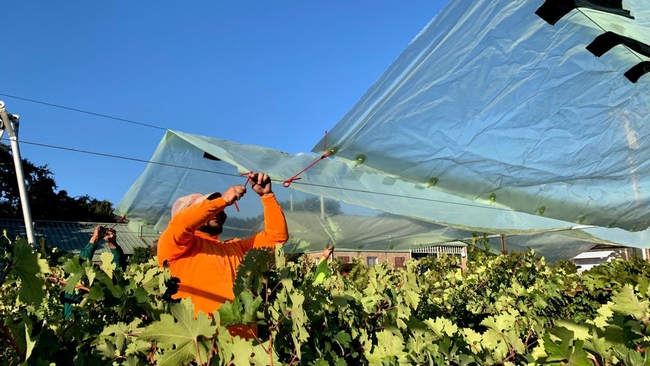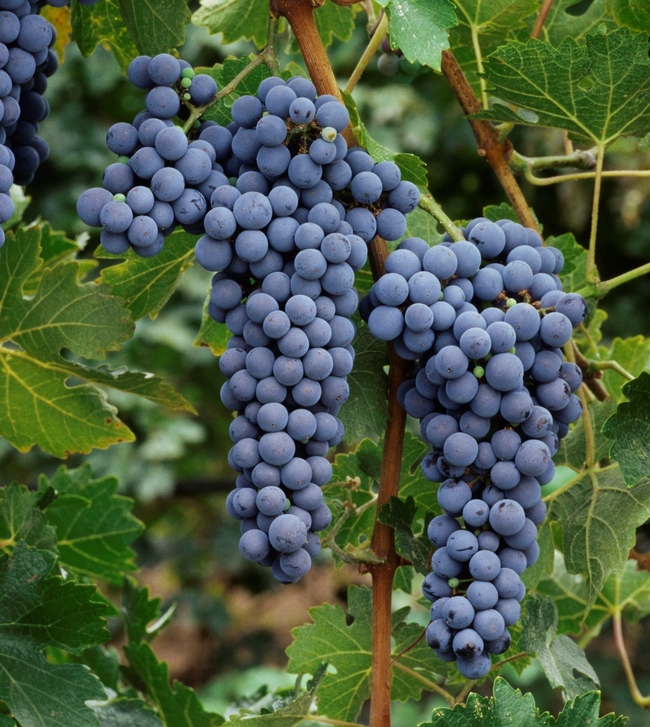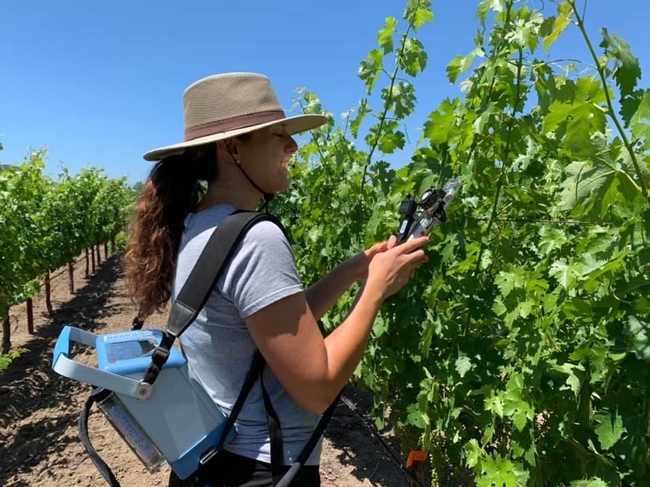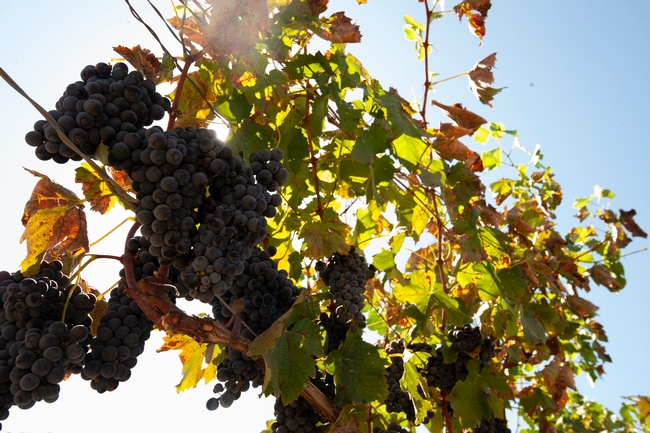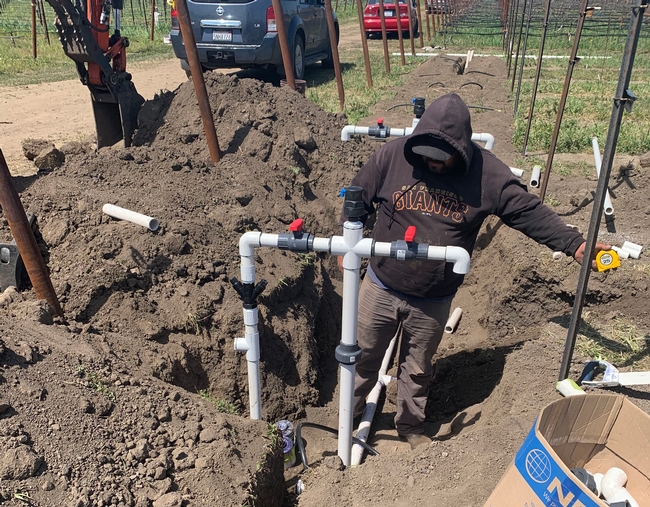Posts Tagged: wine
‘Containergeddon’ at ports cost California farmers $2.1 billion in exports
New research estimates economic losses due to congestion, inefficiencies
Between wildfires, drought, a trade war and the COVID-19 pandemic, the last few years have been hard on California farmers. But recent research by agricultural economists from UC Davis and the University of Connecticut suggests that economic losses to California agriculture from recent supply chain disruptions may have an even greater economic impact.
In an article titled “‘Containergeddon' and California Agriculture,” researchers estimate that there was a 17% decline in the value of containerized agricultural exports between May and September 2021, resulting from recent port congestion. This amounts to around $2.1 billion in lost foreign sales, which exceeds losses from the 2018 U.S.-China trade war.
By the peak of the disruption in September 2021, nearly 80% of all containers leaving California ports were empty – about 43% fewer filled containers leaving California's ports than there were prior to the pandemic. And since 40% of filled shipping containers leaving California's ports are filled with U.S. agricultural products – around a third of which are from California – farmers in the state experienced significant lost export opportunities.
By September 2021, there were around 25,000 fewer containers filled with agricultural products leaving California ports than there were in May 2021. Processed tomatoes, rice, wine and tree nuts saw the sharpest average trade declines.
“We calculated California tree nut producers lost about $520 million,” said Colin Carter, UC Davis Distinguished Professor of agricultural and resource economics. “This was followed by wine with a loss of more than $250 million and rice with about $120 million lost.”
During the pandemic, an increase in household savings led to increases in consumer spending, with many of these additional goods being imported from Asia. California ports were overwhelmed by the added shipping containers coming in from Asia. At times, bottlenecks at Southern California ports left more than 80 vessels waiting off the coast to unload. Docks and warehouses ran out of space and the turnaround time for shipping containers nearly doubled.
Increased U.S. demand for imported goods from Asia also led to increased demand for empty shipping containers in Asia. Prior to the pandemic, freight rates for shipping containers from Shanghai to Los Angeles were already higher than the return trip from Los Angeles, but this gap widened significantly after COVID-19. By September 2021, the fee to ship a 40-foot container from Shanghai to Los Angeles had increased sixfold to $12,000 – while the return trip from Los Angeles was only $1,400.
The high prices for containers from Asia, coupled with shipping delays from the high volume of imported goods entering California ports, made it more profitable for shippers to return containers to Asia empty, rather than waiting at the ports to have them loaded with U.S. exports for the return trip.
“If port inefficiencies persist, the ramifications for California agriculture will extend beyond the immediate loss of foreign sales, as importers begin to view California as an unreliable supplier of agricultural products,” Carter said.
To learn more about the supply chain disruptions at California ports, and their effect on California agriculture, read the full article by Colin Carter (Distinguished Professor in the Department of Agricultural and Resource Economics at UC Davis), Sandro Steinbach, and Xiting Zhuang (assistant professor and Ph.D. student, respectively, both in the Department of Agricultural and Resource Economics at the University of Connecticut): “‘Containergeddon' and California Agriculture,” ARE Update 25(2): 1–4. UC Giannini Foundation of Agricultural Economics, online at https://giannini.ucop.edu/filer/file/1640021835/20297/.
ARE Update is a bimonthly magazine published by the Giannini Foundation of Agricultural Economics to educate policymakers and agribusiness professionals about new research or analysis of important topics in agricultural and resource economics. Articles are written by Giannini Foundation members, including University of California faculty and Cooperative Extension specialists in agricultural and resource economics, and university graduate students. Learn more about the Giannini Foundation and its publications at https://giannini.ucop.edu/.
Suppliers, retailers warn California grape growers of herbicide shortages
Supply-chain crisis forces some to pivot to mechanical, biocontrol measures
Driving through her vineyards on a chilly morning in December, Hortencia Alvarado is taking comfort – for now – that the weeds she sees are all yellow. But there remains a nagging worry that, like the pesky plants, is merely lying dormant for the season.
When March rolls around, and the first signs of new green growth appear on the vines, Alvarado and other vineyard managers will again have to confront the ongoing shockwaves of the global supply-chain crisis.
Growers of grapes – the third-highest valued agricultural commodity in California at $4.48 billion in 2020 – likely won't be able to access the herbicides that they usually apply.
“I definitely need to start thinking and considering it because I don't want to be in that situation where I don't have [the herbicide] when I need it,” said Alvarado, a vineyard manager in the San Joaquin Valley.
Imperfect alternatives
She first noticed the effects of the shortages this past August, during the application following the harvest of early varietals. Alvarado's agricultural pest control adviser had recommended a different product, instead of their usual standby, Rely – because none of the handful of suppliers in California could find it.
Then Alvarado's foreman started reporting that the substitute wasn't controlling the weeds.
“We were using some other stuff that wasn't as good, so basically we were wasting money on stuff that wasn't doing what we wanted it to do,” Alvarado explained.
The need for more machines or labor is just one result of the herbicide shortage, said George Zhuang, University of California Cooperative Extension viticulture farm advisor in Fresno County. Zhuang has received “a lot” of calls from growers about the chemical supply issues, which are also affecting fertilizers. He's been urging them to move away from traditional herbicides to mechanical means or biocontrol such as sheep or fowl – even though they might be more expensive.
Zhuang estimates that while a weed program comprises 5% to 10% of total production costs in a normal year with the usual herbicides, the use of nonchemical alternatives could hike that percentage up to 10% to 20%. In addition to their impact on the bottom line, effective herbicides are especially crucial to grape growers because vines – unlike tree crops – cannot naturally shade out weeds with expansive canopies.
“Right now, people can still scramble around and find some limited chemicals to make sure the crop is successful for the harvest, but if the situation goes for another year, I think there's going to be a panic in farming communities,” Zhuang said.
Herbicide challenges expected to linger
Unfortunately, the availability of certain products is likely going to be “challenged” into at least the middle of 2022, according to Andy Biancardi, a Salinas-based sales manager at Wilbur-Ellis, an international marketer and distributor of agricultural products and chemicals. Biancardi said that the suppliers he talks to are advising people to make preparations.
The supply of glyphosate, the key component in products such as RoundUp (used by many Midwestern farmers), appears to be most affected, Biancardi said. As a result, that shortage has put the squeeze on alternatives such as glufosinate, used in products like Rely – the herbicide favored by many California grape growers.
“The cost of glufosinate has definitely gone up because there just isn't enough, so everyone is obviously marking it up,” said Biancardi, who estimates that prices for both glyphosate and glufosinate are up 25% to 30% for growers.
Alvarado said that while large commercial operations are able to pay the premium prices or shift to other weed control measures, some smaller growers have essentially given up the fight – simply letting the weeds take over.
“They're just letting it go wild until the dormant season,” she said. “They're hoping that – by when they do start to spray [around March] – they'll hopefully have that Rely.”
Silver lining to supply crisis?
Large-scale growers and retailers are buying up those scarcer products when they can, in anticipation of future shortages during critical times. Biancardi said that while his company traditionally runs inventories down at the end of the season, they are instead stocking up on herbicides that customers will demand.
“Careful planning and forecasting is going to be more important than ever, that's really the key,” he said. “At this point we can't guarantee ‘business as usual,' based on what we're hearing.”
Shaking off old habits might actually bring some benefits to business, according to Alvarado, as a forced shift away from chemicals could prove to be a selling point for customers, from a sustainability and marketing standpoint.
“Out of this shortage, there might be some good, some wins,” she said, “but at the same time, we're going to need some answers – I think it's going to be a bumpy road.”
Calling the confluence of drought, record heat and a shortage of chemicals a “perfect storm,” Zhuang said that consumers could start feeling those jolts as well.
“Eventually, somebody is going to eat the costs – either the farming community or the consumer is going to eat the cost, I hate to say it,” he said.
Researchers pinpoint drought-resistant traits in grape rootstocks
Findings could help wine industry adapt to climate change
Scientists at UC Davis have identified new root traits that help grapevines resist drought. The findings, published in the journal Annals of Botany, could speed up the development of grape rootstocks that protect vines from dry conditions, helping the grape and wine industry adapt to climate change.
The research, led by Department of Viticulture and Enology Assistant Professor Megan Bartlett, comes as 80% of California is experiencing extreme drought.
Most grapevines are not rooted directly into the ground but are instead grafted onto a rootstock, which forms the underground part of the plant and supports growth above ground.
“Rootstocks are an important tool to manage water stress,” Bartlett said. “Our goal was to identify traits that make rootstocks drought tolerant, so that grape breeders can amplify these traits in new varieties.”
Root cell traits
The study focused on traits measuring drought responses in living root cells.
The research specifically identified capacitance – which measures how much roots shrink as they dehydrate – as an important trait for drought tolerance.
“The water that enters the roots has to cross through a band of living cells to reach the xylem – the network of pipes that carries water up to the leaves,” said Bartlett. Most research has focused on xylem traits, but the living cells are often the first to be damaged during drought.
Water stress can shrink, deform, or even kill the living cells, causing the roots to shrivel away from the soil and lose access to the remaining soil water. Vines are then unable to replace water lost to evaporation and are forced to close the stomata – the small pores on the leaves that take in carbon dioxide for photosynthesis – to prevent severe dehydration. But closing the stomata stops photosynthesis and starves the vine of the sugars it needs to grow and ripen fruit.
This study is the first to test whether traits measuring root shrinkage and cell collapse can capture differences in rootstock drought tolerance.
Cell traits and drought tolerance
The researchers grafted Chardonnay onto eight commercial rootstocks. Half of the vines experienced drought conditions and half were kept well-watered in a greenhouse experiment.
The study found the eight rootstocks were surprisingly diverse and varied widely in their traits. The rootstocks also appeared to acclimate to drought by changing their traits in that the droughted vines were less susceptible to shrinkage and cell collapse than the well-watered vines.
Among the traits, capacitance was especially important for drought tolerance. The rootstocks with a lower capacitance (less root shrinkage) were better able to maintain photosynthesis during drought than other rootstocks.
“This research gives us a new trait to target for breeding more drought tolerant rootstocks,” study co-author and Ph.D. student Gabriela Sinclair said.
The research was supported by the American Vineyard Foundation, UC Davis, and by donations to the department from the Rossi family. Researchers at the University of British Columbia and the USDA-ARS Crops Pathology and Genetics Research Unit also contributed to the study.
Increasing temperatures led to better-tasting wine grapes, but for how long?
Study shows sugar, color content should be watched
Warming temperatures over the past 60 years have led to increased wine quality, but a new study looking at sugar and color content in grapes indicates the industry may be facing trouble if trends continue, according to collaborative research out of the University of California, Davis, and University of Bordeaux.
“Quality has increased steadily up to now,” said lead author Kaan Kurtural, a professor of viticulture and enology and an extension specialist at UC Davis. “We just don't know the tipping point.”
Kurtural's research, published in the journal OENO One, focuses on two renowned wine regions — Napa Valley and Bordeaux, France.
Researchers looked at ripening, grape quality and temperature data over six decades in both regions and then confirmed the findings with a five-year trial in Napa. They also consulted wine ratings in publications like Wine Spectator to gauge consumer demand.
One key finding: As temperatures exceeded what was considered the optimal level for quality, the grapes produced better wines.
“Previous research had few field data, but a record of assumptions,” said Kurtural.
Other quality factors at play
Temperature is a factor, but the paper suggests that sugar and color content should not be discounted. The authors also identified a biomarker that affects taste, color and other factors that can be the bellwether for climate change in red-skinned wine grapes.
“Temperature is always there,” he said. “Temperature is not your bellwether.”
Higher temperatures can harm grape composition, including color, taste and aroma. Researchers examined pigment and sugar content of five California vintages of cabernet sauvignon, finding that as the grapes got sweeter the skin and color deteriorated.
The degradation of these quality-related compounds and the observed plateaus of wine quality ratings suggests there can be too much of a good thing.
Researchers have long theorized that increasing temperatures from climate change would lead to shifts in wine-growing regions, opening up some new areas for vineyards and making others unsustainable.
That shift could be a boon to some economies and devastating to others, something the industry should watch.
“Since the 1980s, grapes got riper and they were able to make better flavor and color compounds,” Kurtural said. “Are we going to lose this or adapt more?”
Gregory A. Gambetta with the University of Bordeaux is a corresponding author on the paper.
For more information:
- Kaan Kurtural, Viticulture and Enology, cell 707-200-5378, skkurtural@ucdavis.edu
- Amy Quinton, UC Davis News and Media Relations, cell 530-601-8077, amquinton@ucdavis.edu
- Emily C. Dooley, College of Agricultural and Environmental Sciences, cell 530-650-6807, ecdooley@ucdavis.edu
Coastal grape growers can use less water during drought
Study finds using less doesn't compromise quality
California grape growers in coastal areas can use less water during times of drought and cut irrigation levels without affecting crop yields or quality, according to a new study out of the University of California, Davis.
The findings, published today (Sept. 1) in the journal Frontiers in Plant Science, show that vineyards can use 50% of the irrigation water normally used by grape crops without compromising flavor, color and sugar content.
It sheds new light on how vineyards can mitigate drought effects at a time when California is experiencing a severe water shortage and facing more extreme weather brought on by climate change, according to lead author Kaan Kurtural, professor of viticulture and enology and an extension specialist at UC Davis.
“It is a significant finding,” Kurtural said. “We don't necessarily have to increase the amount of water supplied to grape vines.”
Growers will also be able to use this information to plan for the next growing season. “Everybody's worried about what's going to happen next year,” he said.
Kurtural and others from his lab studied irrigation and cabernet sauvignon grape quality at a research vineyard in Napa Valley over two growing seasons, a rainy one in 2019 and a hyper-arid one in 2020.
They focused on crop evapotranspiration, which was the amount of water lost to the atmosphere from the vineyard system based on canopy size. The weekly tests used irrigation to replace 25%, 50% and 100% of what had been lost by the crop to evapotranspiration.
Researchers found that replacing 50% of the water was the most beneficial in maintaining the grape's flavor profile and yield. The level of symbiotic arbuscular mycorrhizal fungi, which help grapevines overcome stresses such as water deficits, was also not compromised. And the water used to dilute nitrogen application was also reduced, making the process more environmentally friendly.
The water footprint for growing grapes also decreased. For both the 25% and 50% replacement levels, water use efficiency increased between 18.6% and 29.2% in the 2019 growing season and by 29.2% and 42.9% in the following dry year.
While focused on cabernet sauvignon, most red grapes will respond similarly, he said.
“In the end, drought is not coming for wine,” Kurtural said. “There doesn't need to be a tremendous amount of water for grapes. If you over irrigate in times like these, you're just going to ruin quality for little gain.”
Members of Kurtural's lab — Nazareth Torres, Runze Yu, Johann Martinez-Lüscher and Evmorefia Kostaki — are also credited as authors.
University of California Agriculture and Natural Resources provided partial funding.
For more information, contact:
- Kaan Kurtural, Viticulture and Enology, skkurtural@ucdavis.edu
- Amy Quinton, UC Davis News and Media Relations, amquinton@ucdavis.edu
- Emily C. Dooley, College of Agricultural and Environmental Sciences, ecdooley@ucdavis.edu


